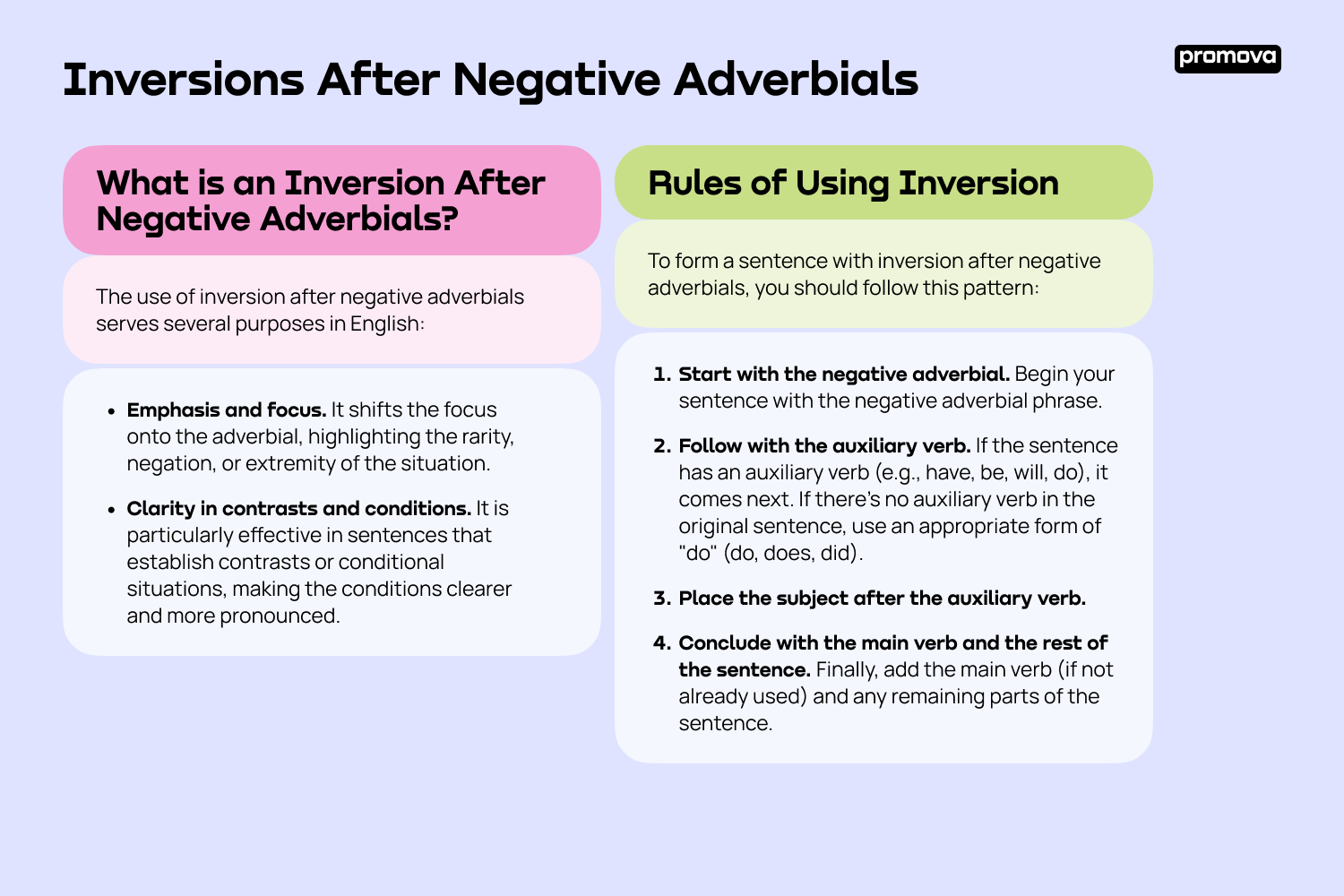Inversions After Negative Adverbials
Contents
Inversions after negative adverbials are a useful tool that helps to put an emphasis on certain points during written and spoken communication. In this article, you will delve into the essence of inversion after negative adverbials, including its role and usage rules.
What is an Inversion After Negative Adverbials?
Inversion refers to the swapping of the subject and the auxiliary verb in a sentence structure. When this inversion follows a negative adverbial, it creates a sentence that not only emphasizes the adverbial but also enhances the overall stylistic quality of the statement.
The use of inversion after negative adverbials serves several purposes in English:
- Emphasis and focus. It shifts the focus onto the adverbial, highlighting the rarity, negation, or extremity of the situation.
- Clarity in contrasts and conditions. It is particularly effective in sentences that establish contrasts or conditional situations, making the conditions clearer and more pronounced.
Negative adverbials are words or phrases that provide information about the time, place, manner, or degree and have a negative connotation. Examples include "never," "rarely,"
5
Rules of Using Inversion
To form a sentence with inversion after negative adverbials, you should follow this pattern:
- Start with the negative adverbial. Begin your sentence with the negative adverbial phrase.
- Follow with the auxiliary verb. If the sentence has an auxiliary verb (e.g., have, be, will, do), it comes next. If there's no auxiliary verb in the original sentence, use an appropriate form of "do" (do, does, did).
- Place the subject after the auxiliary verb.
- Conclude with the main verb and the rest of the sentence. Finally, add the main verb (if not already used) and any remaining parts of the sentence.
This structure is fixed and shouldn’t be changed in any case. Below, you will find some examples and contexts when you can use inversion.

Inversion Examples
There are many situations when you can use inversion. The negative adverbial you choose affects the meaning and style of communication.
- Hardly, barely, scarcely, no sooner. These adverbials are commonly used to communicate about the situation or action that goes immediately after another one in the past. Generally, the sentence with inversion after these negative adverbials are formed in past perfect.
- Hardly had I walked into the room when I noticed the silence.
- Barely had we started the meeting when the power went out.
- Scarcely had she begun to speak when she was interrupted.
- No sooner had we sat down to eat than the doorbell rang.
- Never, rarely, and seldom. As understood from the words, sentences with such adverbials help to communicate the events that occur rarely or never. In most situations, such sentences are formed in present or past perfect tense.
- Rarely have I made mistakes.
- Never had we seen so many people in the match.
- Little. A sentence with inversion after “little” helps to put the accent on insufficiency, preparing the audience for the significance of what follows. Here are some examples:
- Little did he know about the surprise waiting for him. (He didn’t know about the surprise).
- Little had she expected such a warm welcome. (She didn’t expect such a warm welcome).
- Little could they imagine how their project would change the world. (They couldn’t imagine how their project would change the world.)
By understanding and correctly applying inversion after these words, you can emphasize your messages more deeply.
Conclusion
Using inversion after negative adverbials is not just a grammatical exercise; it is a tool for enhancing expressiveness and precision in communication. It allows you to not only convey information but also evoke emotion, emphasize key points, and create a memorable impact on the audience. Mastery of this structure can significantly enrich one's English language skills, enabling more dynamic and effective expression.
Comments